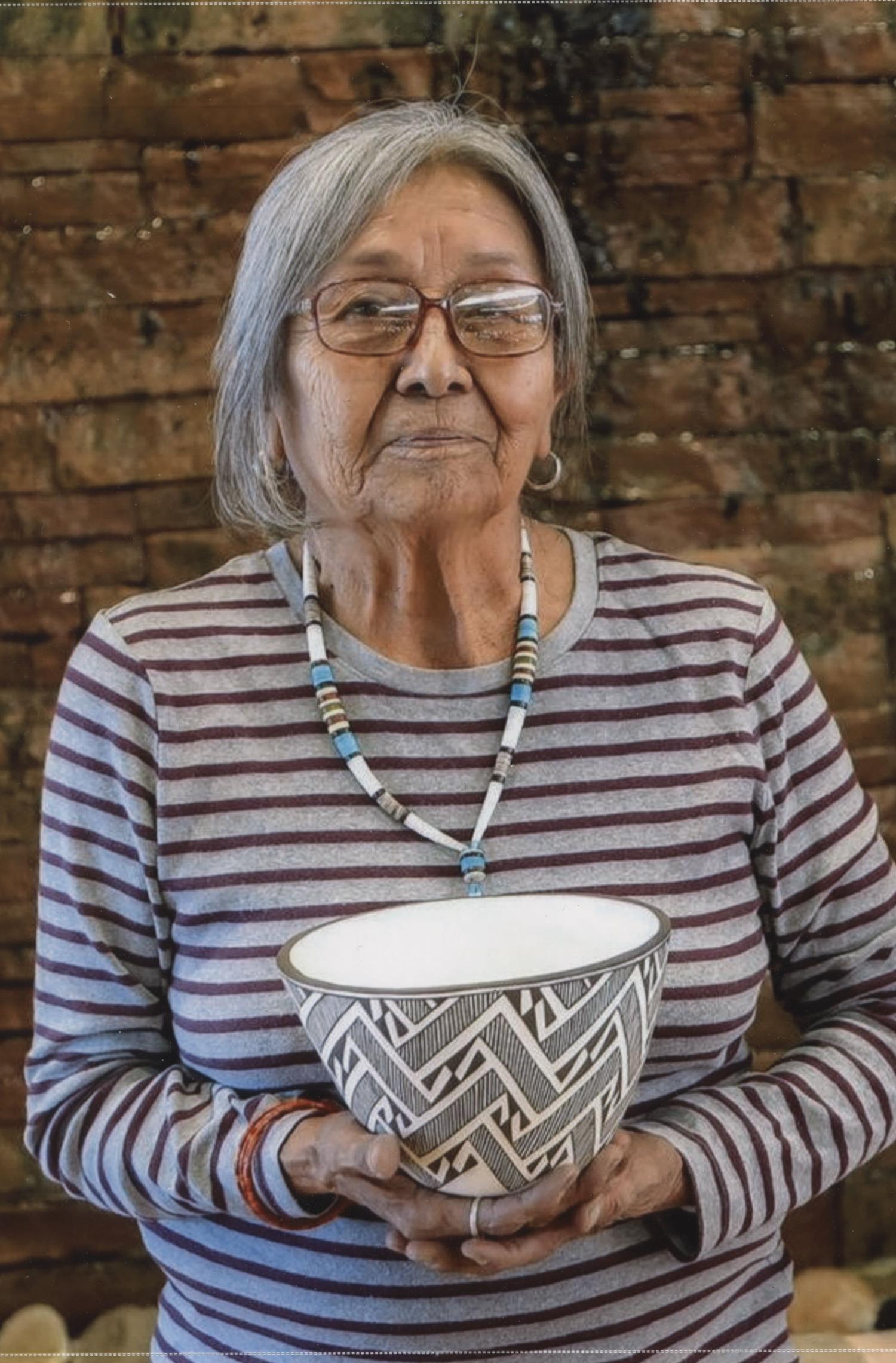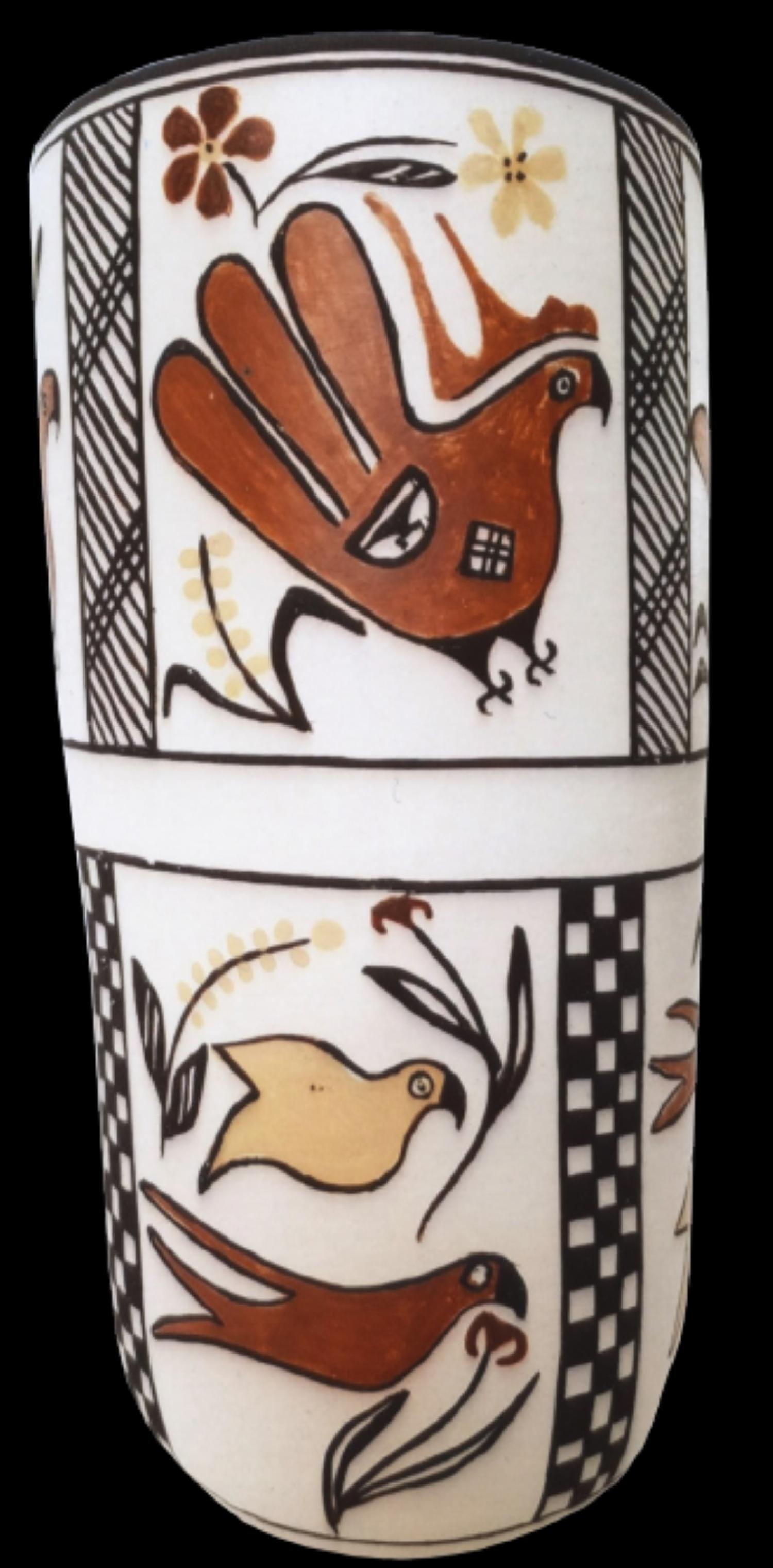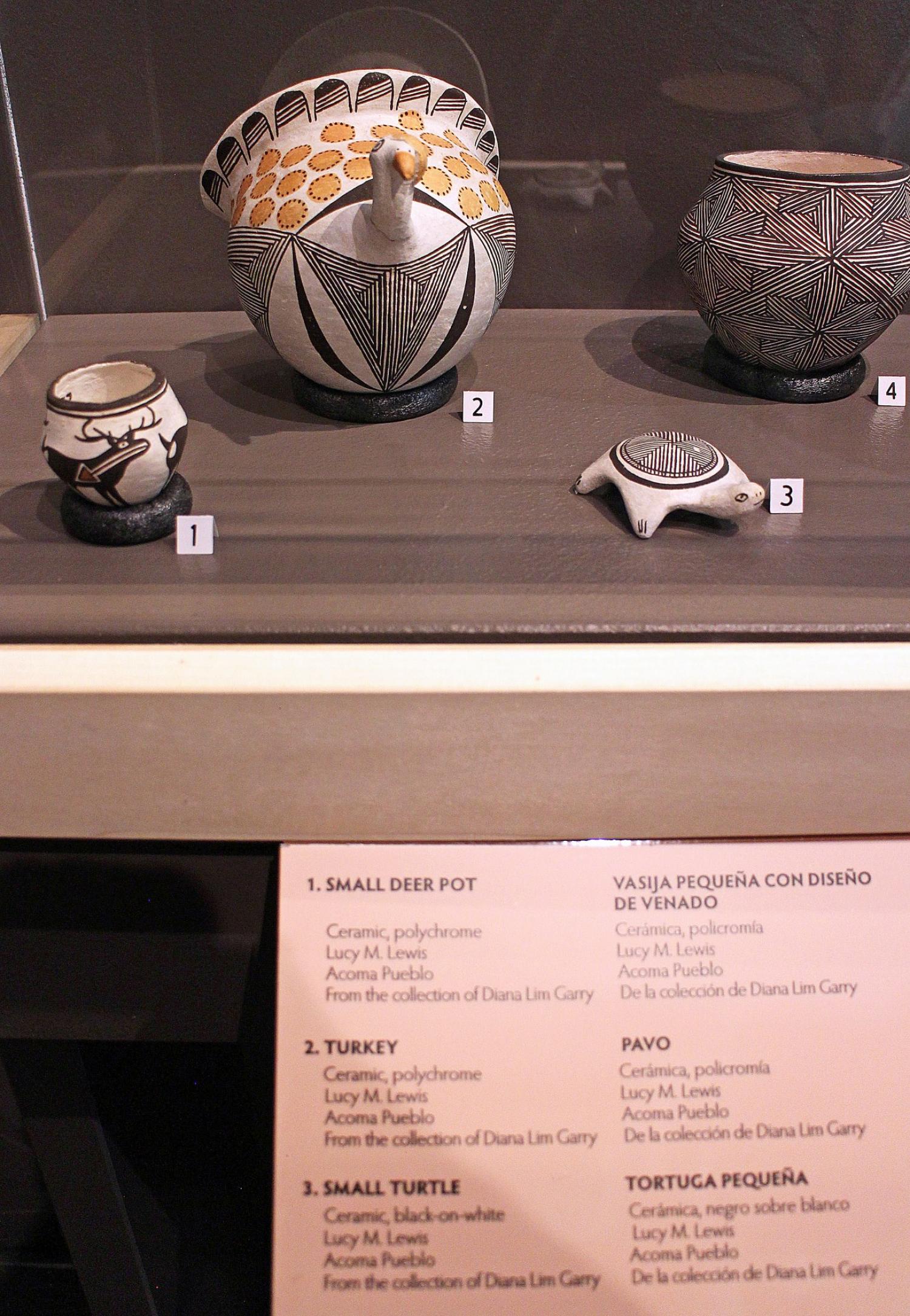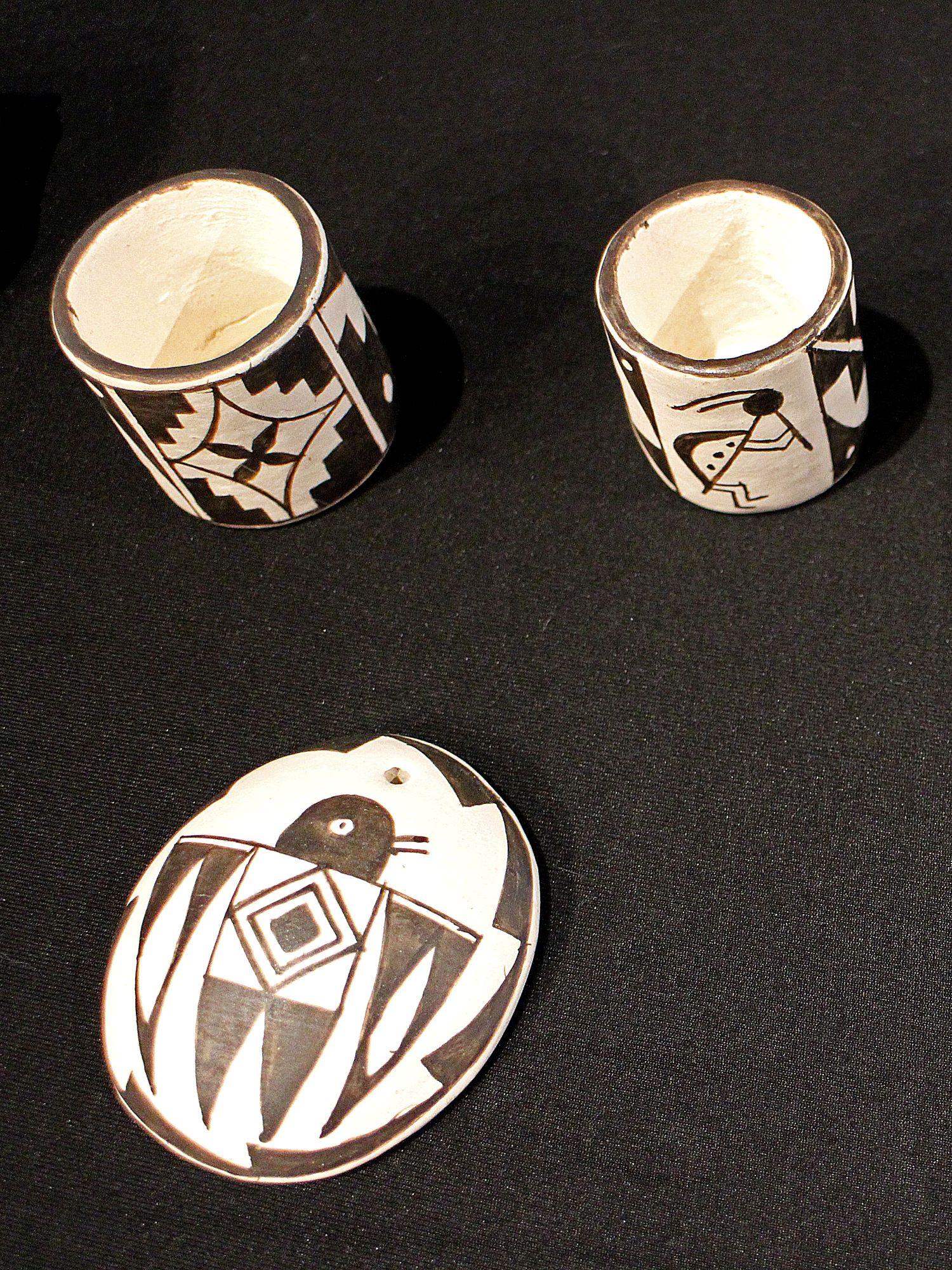Honoring the traditions of people and place
Top image: Carmel Lewis Haskaya enjoying the Colorado outdoors while she was a CU Boulder student (Photo: Lewis family)
Newly opened exhibit at the University of Colorado Museum celebrates ceramic artist’s donation and the legacy of her family and community
A new piece of Acoma Pueblo pottery begins, in a way, with all the pottery that came before it.
Artisans finely grind shards of old pottery and mix it into clay gathered from Acoma Pueblo land, hand-forming the light yet strong vessels for which they are renowned. There are no precise measurements, no written recipes, for the clay or slip or mineral paints that come together in Acoma Pueblo pottery; “you just know when it’s right,” says artist Dolores Lewis Garcia.

Noted Acoma Pueblo ceramics artist Carmel Lewis Haskaya, a proud CU Boulder alumnus, ensured that her love for her community and its traditions would unite with her love for CU Boulder by donating one of her pieces to the University of Colorado Museum.
Lewis Garcia learned the art from her mother, Lucy M. Lewis, the famed New Mexico ceramics artist known for reviving traditional pottery techniques whose work is displayed in the Smithsonian National Museum of the American Indian. Most of Lewis’ nine children learned by watching her and also became ceramic artists, including her youngest, Carmel Lewis Haskaya.
Lewis Haskaya was not only a respected ceramic artist, but a proud University of Colorado Boulder alumnus. Before her death in 2019, she ensured that her love for her community and its traditions would unite with her love for CU Boulder by donating one of her pieces to the University of Colorado Museum.
The vibrant cylindrical pot is a centerpiece of the new exhibit “A Family Tradition: Acoma pottery, CU and the Lewis family,” which opened with a reception and ribbon cutting Tuesday evening.
“We are delighted to highlight and honor the important artworks that this family has shared with us,” says Nancy J. Stevens, CU Boulder professor of anthropology and director of the Museum Institute. “It represents a pivotal point for connecting communities and growing meaningful collaborations into the future.”
The exhibit features pieces by Lucy Lewis and many of her children, including Forever Buff Carmel Lewis Haskaya.
“(Lewis Haskaya’s cylinder jar) is not just an object or a gift,” explains William Taylor, a CU Boulder assistant professor of anthropology and CU Museum curator of archaeology who partnered with the Lewis family to create the exhibit.
“For many folks, creating pottery is a way to impart something of yourself in a permanent and lasting way. Having this pottery at CU means that a part of Carmel and her family will always be here in Boulder.”
Learn by watching
Lewis Haskaya belonged to an artistic lineage that can be traced in centuries. For hundreds of years, Acoma Pueblo artists have gone to certain spots on their land to collect the clay, white slip, wild spinach and oxides that are the raw materials for their pottery.
“Being an Acoma potter, there’s a lot of work that goes into it,” Lewis Garcia says.
“Everything is gathered from the land and hand-processed,” adds Claudia Mitchell, also a famed Acoma Pueblo artist and Lewis’ granddaughter. “It teaches you to take your time and be present; you’re putting yourself into the work.”
As a child, Lewis Haskaya learned these traditions and techniques watching her mother. When she came to CU Boulder through the American Indian Educational Opportunity Program and built a career with the Native American Rights Fund, she never forgot or outgrew her community, Mitchell says. Eventually, Lewis Haskaya returned to her community at Acoma, west of Albuquerque, New Mexico, and became an accomplished artist.
Lewis Haskaya was a student of history and art traditions from around the world and was known for creating cylinder vessels in the style of ones found at Chaco Canyon, Mesa Verde and other ancient sites, adding her own touch to traditional designs.

The cylindrical vessel made by noted Acoma Pueblo artist Carmel Lewis Haskaya, which she donated to the University of Colorado Museum before her death in 2019.
“She had the hardest time grinding mineral paints,” Lewis Garcia recalls with a laugh, adding that her sister eventually conquered the hurdle that many artisans using traditional techniques encounter.
Like her mother and siblings, and now her nieces and nephews, Lewis Haskaya walked Acoma land to specific spots for the gray and yellow clays, the minerals and the plants that are the foundation of traditional techniques. “To get the white slip, it’s not in an easy place,” Lewis Garcia says. “It’s underground and there’s a big boulder on it. You have to use it sparingly.”
Though it’s more common now to use kilns rather than dung fires, the process of thinning vessel walls, of burnishing with a stone, of applying the geometric patterns associated with Acoma Pueblo pottery hasn’t changed for centuries.
‘The ties that bind us together’
While pottery is revered as art, “in our traditional ways, it’s a utility, it’s an item that we use,” says Benny Shendo Jr., CU Boulder associate vice chancellor for Native American affairs and a member of the Jemez Pueblo Tribe. “And it plays a big role in our ceremonial life.”
Mitchell notes that traditional pottery helps not only those who make it, but those who use it to “ground ourselves to the place that we’re from; it’s that connection that we have to our land and to our people—not only just for personal use, but for community use. It gives us that tie to one another. We’re keeping those traditions alive not only through our dance and song but through our pottery.
“Those are the ties that bind us together, that make us a people. It’s important to keep those ties, to make sure that those things—the pottery making, the dancing, the singing—all of those are taught to our younger generations, because that helps them identify who they are and where they are. It helps give them a sense of place and sense of purpose.”
“It’s part of life,” says Diana Lim Garry (Anth'71), Lucy Lewis’ granddaughter who lives in Boulder and helped bring the exhibit to life, loaning pieces from her own collection. “Everywhere we go—you’re walking on a hike and you’re walking along the streambed, and you’re saying, ‘Would that make a good polishing stone?’ You go along, even (in) roadcuts there’s all these pretty colors of the minerals in the rocks: ‘Would that make good paint?’ It’s always on your mind that this is something that’s been done for a long time and will continue to be done thanks to my aunts and my cousins.”
Mitchell adds that a pottery vessel made in traditional ways allows the Acoma Pueblo people to say “I have my piece of the rock. That’s how we identify ourselves, by place and name, that’s our place in this world, and no matter where we go in this world, we can always go back to that one place, and that’s where we belong. For our people, that’s who we are, that’s where we’re from.”
A Family Tradition: Acoma pottery, CU and the Lewis family” is open to the public during regular museum hours, which are 9 a.m. to 5 p.m. Tuesday through Friday and 10 a.m. to 4 p.m. Saturday and Sunday.

Claudia Mitchell (left), Dolores Lewis Garcia (center) and Diana Lim Garry (right) with the vessel made by Carmel Lewis Haskaya, Lewis Garcia's sister and Mitchell's and Lim Garry's aunt; Lewis Haskaya donated the vessel to the University of Colorado Museum.

Pieces made by famed Acoma Pueblo artist Lucy M. Lewis are part of the new University of Colorado Museum exhibit "A Family Tradition: Acoma pottery, CU and the Lewis family."

Following in the footsteps of her grandmother, Lucy M. Lewis, Acoma Pueblo artist Claudia Mitchell made these pieces using traditional techniques and designs.
Did you enjoy this article? Subscribe to our newsletter. Passionate about the University of Colorado Museum? Show your support.

